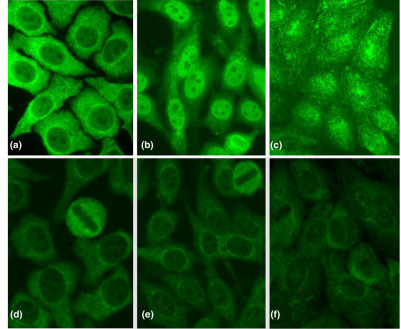Understanding Your Antinuclear Antibody Test Results: Positive vs. Negative and Causes
An antinuclear antibody (ANA) test is a blood test that looks for antinuclear antibodies in the blood. Antinuclear antibodies are proteins that are directed against the body’s own nucleus, which is present in every cell. The presence of these antibodies may indicate an autoimmune disease, but it’s essential to understand the test, its results, and what they mean for your health.
What is an Antinuclear Antibody Test?
The antinuclear antibody test is performed by taking a blood sample from a vein in your arm. The blood sample is then sent to a laboratory for analysis. During the test, the technician will add a fluorescent antinuclear antibody to the blood sample. If antinuclear antibodies are present, the fluorescent antibodies will bind to them, causing a fluorescent reaction that can be viewed under a microscope.
What Do Antinuclear Antibodies Indicate?
Antinuclear antibodies indicate the presence of autoimmune activity in the body. When the immune system mistakenly targets the body’s own cells and tissues, it can lead to various autoimmune diseases.
Who Should Consider Getting an Antinuclear Antibody Test?
Individuals experiencing symptoms suggestive of autoimmune diseases, such as joint pain, muscle weakness, skin rashes, and fatigue, should consider getting an antinuclear antibody test. Those with a family history of autoimmune diseases or certain unexplained symptoms should also discuss the test with their healthcare provider.
Interpreting Antinuclear Antibody Test Results
What Does a Positive ANA test Result Mean?
A positive ANA test result indicates the presence of antinuclear antibodies in the blood. However, it is important to note that a positive result does not necessarily mean that an individual has an autoimmune disease. It signifies the need for further evaluation to determine the underlying cause of the positive result. The ANA level is also an important information.
Possible Causes of Positive Antinuclear Antibody Test Results
There are various reasons why a person may test positive for antinuclear antibodies, including autoimmune diseases like systemic lupus erythematosus (SLE), rheumatoid arthritis, scleroderma, mixed connective tissue disease, and others. In some cases, a positive ANA test may also occur in healthy individuals or due to viral infections, medications, or other non-autoimmune conditions.
What Is Considered a Negative Result?
A negative ANA test result indicates the absence of antinuclear antibodies in the blood. However, it does not completely rule out the possibility of an autoimmune disease. Sometimes, individuals with certain autoimmune conditions may have negative ANA results, so a comprehensive evaluation is necessary for accurate diagnosis.
Relationship Between Antinuclear Antibodies and Autoimmune Diseases
Which Autoimmune Diseases are Associated with Positive Antinuclear Antibody Test Results?
Positive antinuclear antibody test results are commonly associated with autoimmune diseases such as systemic lupus erythematosus (SLE), rheumatoid arthritis, scleroderma, and mixed connective tissue disease. However, it’s important to note that not all individuals with these conditions will test positive for ANAs, and a positive ANA test alone is not sufficient for definitive diagnosis.
Connection Between Antinuclear Antibodies and Systemic Lupus Erythematosus (SLE)
Positive ANA results are often seen in individuals with SLE, but the presence of these antibodies does not confirm the diagnosis of SLE. Other clinical and laboratory findings, including symptoms, physical examination, and additional blood tests, are also important in the diagnosis of SLE.
Is a Positive Antinuclear Antibody Test a Definitive Diagnosis for an Autoimmune Disease?
No, a positive ANA test is not a definitive diagnosis for an autoimmune disease. It serves as a screening tool that prompts further investigation and diagnostic testing to determine the specific autoimmune condition causing the symptoms.
Preparing for an Antinuclear Antibody Test
What Should I Do to Prepare for an Antinuclear Antibody Test?
Prior to the test, patients are advised to follow any specific instructions given by their healthcare provider, which may include fasting for a certain period or temporarily discontinuing medications that could interfere with the test results. It’s important to communicate any underlying medical conditions or medications to the healthcare provider before the test.
Consulting a Rheumatologist for Antinuclear Antibody Testing
A rheumatologist, a physician specialized in the diagnosis and treatment of arthritis and other rheumatic diseases, is often involved in ordering and interpreting ANA tests. They can provide expert guidance on the implications of the test results and coordinate additional evaluations as needed.
Understanding the Procedure and Potential Side Effects of Antinuclear Antibody Testing
The antinuclear antibody test is a simple blood test that usually involves minimal discomfort. However, some individuals may experience slight bruising or bleeding at the site where the needle was inserted. It’s important to discuss any concerns about the test procedure and potential side effects with the healthcare provider.
When to Seek Further Medical Advice
Interpreting the titer of Antinuclear Antibody Test Results
ANA test results are somtimes given in the form of a titer. The normal is a ration less then 1:80. The higher the ration the more likely there is autoimmune connective tissue disease. Titers very rarely change unless there are from viral infections or from reactions to medications.
Relevance of Antinuclear Antibody Test Results for Diagnosing Autoimmune Diseases
While ANA test results play a significant role in the initial evaluation of suspected autoimmune diseases, they are only part of the diagnostic process. The healthcare provider may conduct additional tests and consider the individual’s medical history and symptoms to make an accurate diagnosis. Many times the tests are positive but if the symptoms don’t fit systemic lupus erythematosus then autoimmune disease is not present.
Follow-Up Tests After Antinuclear Antibody Test
Depending on the initial ANA test results and clinical presentation, the healthcare provider may recommend follow-up tests, including specific autoantibody panels, imaging studies, or consultations with other specialists to further investigate and monitor the individual’s health.
What the ways the lab will check for ANA level ?
Most labs will use two different ways to detect ANA level. The most common is the ELISA test where the serum is run through a solid gel that has ANA antigen to see if there is a reaction between the sera and the antigens. This method has more false positives. The older but the standart method is the immunofluorescence method (IFA) shown below. The brightness of the test is correlated with a titer. A level of 1:80 or greater considered positive.

J. Al-Mughales et al. “Anti-Nuclear Antibodies Patterns in Patients With Systemic Lupus Erythematosus and Their Correlation With Other Diagnostic Immunological Parameters.” Frontiers in Immunology, 13 (2022). https://doi.org/10.3389/fimmu.2022.850759.
J. Damoiseaux et al. “From ANA to ENA: how to proceed?.” Autoimmunity reviews, 5 1 (2006): 10-7 . https://doi.org/10.1016/J.AUTREV.2005.05.007.
Mahler M, Ngo JT, Schulte-Pelkum J, Luettich T, Fritzler MJ – Arthritis research & therapy (2008)



